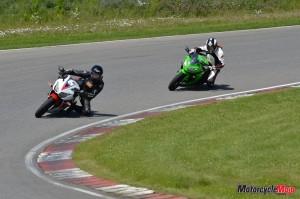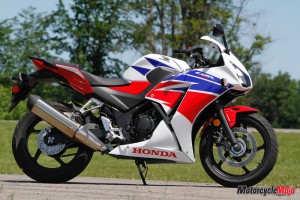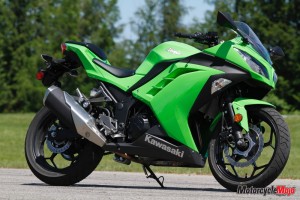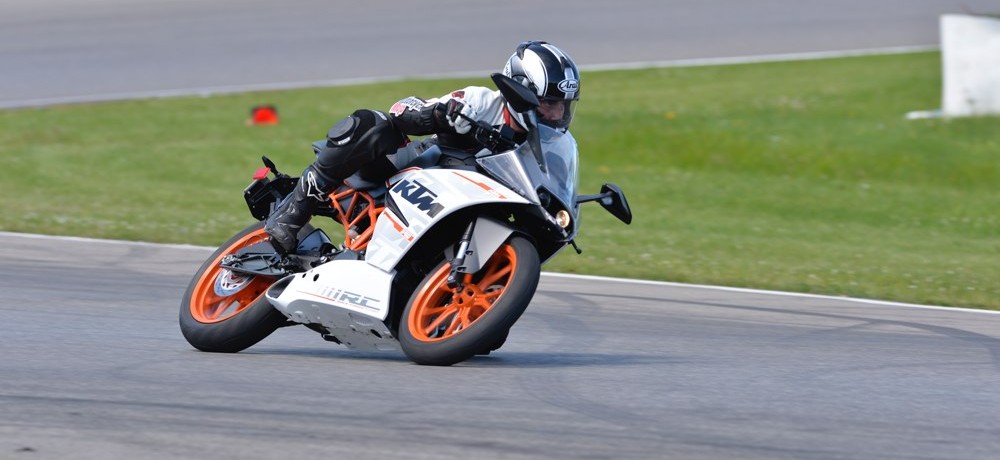If the sub-400 sport bikes available today had its own entry-level race class, which would be the winner?
Probably the most fun I’ve had while racing motorcycles was when I participated in the Honda CBR250R Challenge. That was a single-make spec series meant to introduce young racers to road racing by keeping costs down and rules strict. It’s gone now, at least on a national level, but Kawasaki is currently working to introduce a spec racing series based on the Ninja 300.
Spec series are fine, but there are now enough sporty sub-400 cc bikes on the market to merit a bona fide entry-level race class for young racers on a budget. This motivated a few moto journos and me to hold a track test of the Honda CBR300R, the Kawasaki Ninja 300, the KTM RC390 and the Yamaha R3 at Autodrome St-Eustache in Quebec.
About the Bikes
 The motorcycles were stock, except for the Yamaha, which came with an accessory slip-on muffler. The muffler had a quiet insert installed, so it was no louder than any of the other machines, and it gained no power advantage.
The motorcycles were stock, except for the Yamaha, which came with an accessory slip-on muffler. The muffler had a quiet insert installed, so it was no louder than any of the other machines, and it gained no power advantage.
All the bikes were equipped with OEM tires. The CBR300R and Ninja 300 use IRC Road Winner tires, which, despite the cheesy name, had the best grip. The RC390’s Metzeler Sportec MS tires weren’t as sticky as the IRCs, though they had good feedback and were forgiving when they did start to lose grip at maximum lean angles. The R3’s Michelin Sport Street tires were slippery, losing grip early and abruptly.
The bikes all featured the same suspension adjustability, which was limited to rear preload, and all but the Yamaha were equipped with ABS; the R3 is the only bike in this comparison that does not have an ABS option.
Honda CBR300R
 The Honda CBR300R ($4,699; $5,199 with ABS) is basically the same bike the CBR250R was, but with a longer-stroke engine (63 mm vs. 55 mm) that bumps displacement to 286 cc. The bike now claims 30 hp, placing the CBR at the bottom end of this group in both displacement and output. Despite being one of two singles in this test, it was among the smoothest. At 161.9 kg wet, it is the second lightest among these bikes, behind the KTM.
The Honda CBR300R ($4,699; $5,199 with ABS) is basically the same bike the CBR250R was, but with a longer-stroke engine (63 mm vs. 55 mm) that bumps displacement to 286 cc. The bike now claims 30 hp, placing the CBR at the bottom end of this group in both displacement and output. Despite being one of two singles in this test, it was among the smoothest. At 161.9 kg wet, it is the second lightest among these bikes, behind the KTM.
Its reduced power isn’t as big a deficit as it would appear, though, because the Honda has more bottom-end torque than the Kawasaki and Yamaha, and it is the easiest, most stable and most confidence-inspiring to ride at the limit. It offered the most communicative front-end feedback, and maintained its composed handling regardless of who was at the controls and how heavy they were. It was easier to push the CBR to the edge comfortably, and it responded well to rider input regardless of that rider’s weight. There was no wallowing or bouncing on under-damped suspension, and it was one of two bikes that didn’t exhibit any brake fade.
Kawasaki Ninja 300
 The Kawasaki Ninja 300 ($5,399; $5,799 with ABS) is the oldest bike in this comparison, having grown to 296 cc just two years ago. It’s the second smallest in displacement and, at 38 hp, is third in terms of claimed output. At 174 kg wet, it is also the heaviest bike in this group, though it manages its weight well.
The Kawasaki Ninja 300 ($5,399; $5,799 with ABS) is the oldest bike in this comparison, having grown to 296 cc just two years ago. It’s the second smallest in displacement and, at 38 hp, is third in terms of claimed output. At 174 kg wet, it is also the heaviest bike in this group, though it manages its weight well.
The Ninja’s powerband is flat but it likes to spin; therefore, it had to be kept above 9000 rpm to generate some proper speed. This also meant it was the bike that required the busiest left foot.
Its suspension wasn’t as composed as the Honda’s, though it wasn’t far off. It had a softer fork, which caused it to dive more under braking, and it had slightly softer shock damping, though it didn’t bounce back and wallow after hitting bumps at high speed as did a couple of the other bikes.
Like the Honda, the Kawasaki exhibited the least amount of brake fade, though it needed a slightly firmer squeeze at the lever.
KTM RC390
I came into this comparison with high expectations for the KTM RC390 ($6,599) and left disappointed. It’s the most aggressively styled machine here, and its spec sheet promised great performance. It’s the only bike in this group that has a tubular steel trellis frame, not one made with steel stampings, and it has a rigid cast-aluminum swingarm.
Its 373 cc single boasts the highest output, at 43 hp, and it’s the lightest machine, at 147 kg claimed wet, but that’s without fuel; other manufacturers’ wet weights usually include half a tank of fuel, so add about four kilos to that. That still makes it the lightest by at least 11 kg.
Let the clutch out on the RC and you instantly feel its shuddering power pulses, which you’ll either love or hate. I liked the roughish feel of the bike on the track, but I’m not so sure it’s something I’d like to live with on a daily basis. It felt as if the shock-absorbing dampers in the rear wheel weren’t there. The other single in this match, the CBR300R, was electric-smooth in comparison.
The KTM pulled noticeably harder right off the start than did any of the other machines, and it flexed its extra displacement by continuing to pull hard until it slammed into the rev limiter at 9000 rpm. It felt as though it could easily pull another 1000 rpm, and the spec sheet claims the bike makes peak horsepower at 9500 rpm, leading me to believe that this was a break-in setup. The factory rep present at our comparison, though, couldn’t confirm if this was the case.
My biggest gripe with the bike is with its suspension, which is provided by WP. The RC390 is the only machine that exhibited rear shock fade. On a cold bike, it felt somewhat soft in the rear, but after three laps, the rear began to wallow and swing, almost as if someone had let the oil out of the rear damper. This probably isn’t something that you’d notice on the street, but for a company whose slogan is “Ready to Race,” the RC390 is far from it.
Add to that a fork that has an unusual amount of stiction and the overall setup is less than ideal. On several occasions, when pushing the bike to the limit, the front tire would lose its grip and the bike would push rather uncomfortably toward the outside. This wasn’t a grip issue, but rather the front suspension’s inability to follow the uneven track surface.
It also exhibited a fair amount of brake fade, with the lever coming halfway to the handlebar after several laps, and this despite being the only radial setup.
Yamaha R3
The Yamaha R3 ($4,999) joined the 300 wars this year, though like the KTM, it is slightly larger than the two class veterans. Its 321 cc parallel-twin claims 41 hp, slipping right between the Kawasaki and KTM. At 166 kg wet, it’s just four kilos heavier than the lightweight Honda. Its power characteristics are very similar to the Ninja’s, except that it feels torquier and pulls a bit harder throughout the rev range, and it has a very light shifter.
Its suspension setup was too soft for track riding, almost sloppy, in fact. It wallowed and weaved about through corners to the point of sapping rider confidence. This was something I had noticed when I attended its press launch in the U.S.A., but it was emphasized in the company of the other bikes.
Its brakes required the firmest squeeze for hard stops, and they, too, exhibited some fade after a few laps.
And the Winner Is?
My assessment of these bikes depends entirely on if they will be used on the track in stock or lightly modified form. Completely stock, the two best performers are the CBR300R and the Ninja 300. These two machines have the best suspension, with the Honda being firmer and more stable, and the Kawasaki having the edge in power. The latter gets my vote for best stock bike, with the Honda taking second place.
The R3 has a great engine, feeling very similar to the Ninja 300 in delivery, but with more power at lower revs. Unfortunately, its suspension is too soft, especially in the rear. It would probably be the comfiest setup for the street, so I’d rank the R3 third.
The RC390 has the most powerful engine with a surprising amount of low-end torque, as well as a strong top end. It also has a race-ready chassis,
if not a race-ready suspension setup. It’s the suspension that pushed it to my last choice in stock form, especially since it’s the priciest bike of the bunch.
But What About Modifications
All the bikes would need the same amount of work in preparation for a lightweight racing series, which would include some fork alterations, a different rear shock, a slip-on muffler, race tires and racing bodywork. They would all respond similarly to these modifications.
In that case, the KTM would be my first choice. It has the stiffest chassis, the highest power and the most potential to run upfront in a race, though its brakes would probably need some work, too.
The R3 and the Ninja 300 would probably be neck and neck, with maybe the R3 edging out the Kawasaki with a bit more power (it does have a slight displacement advantage, after all).
The CBR300R is the easiest bike to ride fast, though its lower output would put it at a disadvantage on longer tracks. So, if it’s a championship I’m looking for, it would be my last choice.
I’m crossing my fingers that a race series will be introduced for these bikes in the near future so they can scrap it out on a racetrack to determine which one would be the real winner.












































